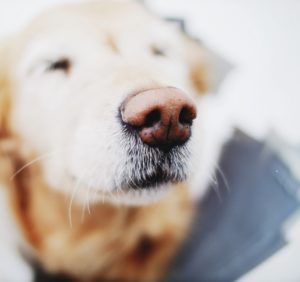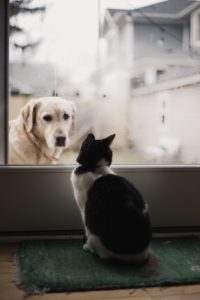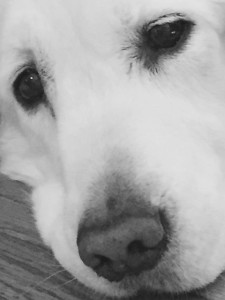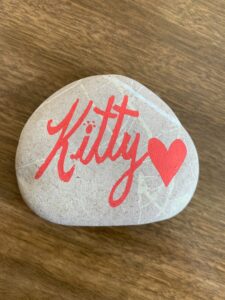Factual information about pet cremation is often hard to come by. Many misconceptions, incorrect notions, myths, and flat out falsehoods are sometimes circulated, further muddying an already confusing, delicate topic. It is our hope that we can help clear up some of those false notions and myths, and offer factual, solid information on such an important and sensitive topic. With this article, we will explain how pet cremation works, what different cremation options exist, and what you receive when your pet’s cremains are returned to you.
The Cremation Process
To start, we would like to offer helpful information and clarity regarding how the cremation process works. Cremation, whether pet or human, follows the same basic process. The Cremation Association of North America summarizes this process in four basic steps:
- Transportation of the deceased from place of death to the crematory
- Secure, cold storage of the deceased prior to cremation
- The cremation process itself
- Return of cremated remains to the authorized agent
We partner with a wonderful local crematory, the Veterinary Hospitals Association (VHA), who follows these same basic steps, as do many human and pet crematories.
When the deceased is received by the facility, they are carefully identified. This is such an important and crucial step and there are many checkpoints in place to assure that the deceased is properly identified at every single step of the process.
As the deceased awaits the cremation process, very often the protocol includes a brief wait in “secure, cold storage.” Cold storage ensures that the deceased human or pet remains perfectly preserved while it waits for cremation to begin.
The next step is the cremation process itself. The deceased is placed in the cremation machine, which is called a “retort”. The retort reaches a very high degree of heat to achieve cremation. In the cremation process, all parts of the body are incinerated. Throughout this process, everything but bone tissue disappears with the heat. After the cremation process has been completed, the material that remains after cooling down consists of bone fragments, called cremains. These are collected from the retort, allowed to fully cool, and then placed in a machine that processes the bone fragments into a coarse powder, resembling ground seashells (sand) on the beach. Just as you may see fragments of seashells that have not fully broken down, you may also see slightly larger fragments of bone. Once the cremains have been fully processed, they are placed in a secure bag, and then moved to their final container (usually an urn).
Next, we’d like to provide other details to clear up some basic misconceptions, myths, and falsehoods commonly believed about cremation and the cremation process. We will also explain the different options available for pet cremation.
“Ashes”?
What do you receive when your pet is returned to you after cremation? Very often, your pet’s remains are called “ashes.” But is this accurate? Not exactly. Strictly speaking, there is no ash remaining after a body has been cremated. What remains is only bone or bone fragments. Those bones are then processed, as explained earlier, so what you are receiving in your pet’s urn is bone material. In the cremation industry, this is referred to as “cremains” or, cremated remains. Many people expect the material to look how ashes are depicted in movies, when in fact, the cremains you will receive back are more of a finely ground, almost sandy texture.
Types of cremation
Communal
One option that many families choose for their pet is communal cremation. Communal cremation means that the pet is placed in a large (human-sized) retort and cremated with other families’ pets. Communal cremains are never returned to the family. Many families choose communal cremation because they feel that they do not need to have the cremains of their pet returned to them. They have memories, photos, and mementos to enjoy and to memorialize their pet, and they feel they do not need to keep the cremains. This cremation option means they do not have cremains returned. The communal cremation process, and the processing of the cremains, means that the pets cremains would actively commingle with the cremains of other pets and are disposed of privately by the crematory.
Separated
Another cremation option that many families select is called separated cremation. This is an option that allows a family to have their pet’s cremains returned to them. In this option, their pet’s body is placed into the large (human-sized) retort several feet apart from other pets. There is a specific and exact amount of space separating each pet. The cremation process takes place and everything is burned away except for the bones (as described above). Contrary to the misinformation sometimes provided, the cremation process is very controlled and there isn’t movement of the bodies throughout the retort. After the cremation process is complete, the bones, or cremains, of each separate pet are in the place they originally began. They are carefully collected and kept separate, then processed separately, and bagged.
Every single step of the process involves careful identification, labeling, and documenting to ensure that pets are properly identified at every checkpoint. The number of pets in the retort during separated cremation depends on the size of the pets being cremated separately at the time. What is required is a predetermined amount of space for separation to ensure that pets are kept separate from one another, and that the cremains returned to the family are only their pet’s cremains. Later in this article we will address in more detail how you can be assured that you are receiving just your pet’s cremains.
“Partitioned”
“Partitioned” cremation is another option that some crematories offer. The partitioning device varies depending on the crematory, but in general, this indicates that there are multiple pets in the cremation chamber at a time, and there are barriers, or partitions, used while pets are being cremated. Some crematories use trays as “partitions,” while others have heat-resistant barriers placed between pets. While this hasn’t been proven to have any added benefit as a safeguard against minute amounts of commingling (which we will address momentarily), it does add peace of mind for some families.
Private/Individual
Private cremation, which has also been called “individual” cremation, indicates that the cremation process takes place with only one pet in the retort at one time. Some crematories offer this option, and some families choose it as it gives them even more peace of mind that the cremains they are receiving are just their pet’s cremains. As Peaceful Paws Cremation, a wonderful crematory in Portland, Oregon further explains, “Though this is not necessary for maintaining separation, we acknowledge that some pet owners might prefer this option.”
What does MN Pets offer?
MN Pets partners with the Veterinary Hospital Association (VHA) a crematory which has been in operation for more than 20 years. VHA is operated under the careful guidance of the veterinary community, ensuring that processes and procedures are in alignment with the standard veterinarians desire for their clients and their own pets. More than 200 veterinary clinics in the Twin Cities work with VHA for their pet cremation services. VHA offers communal cremation (no ashes returned), separated cremation (your pet’s ashes returned), and individual cremation (just your pet alone in the retort, and just your pet’s ashes returned).
Commingling of cremated remains or “ashes”
One question that is brought up frequently regards the commingling, or mixing, of ashes. This is a concern for many in the field of human cremation as well. When humans are cremated in retorts, there is an expected minute amount of cremated material left over after cremains have been collected from the machine. That minute amount of leftover material can technically be considered to “commingle” with the cremains of the next body put in the retort. However, this amount of minute commingling is inevitable and unavoidable. The same challenge is present in pet cremation, and Peaceful Paws Cremation summarizes this well:
“Although the crematory will take all reasonable efforts to remove all of the cremated remains from the cremation chamber, some dust and residue from the process will be left behind…Active commingling cannot by definition, occur with private cremation. However, while every effort will be made to avoid commingling, inadvertent and incidental commingling of some minute particles of cremated remains from the residue of previous cremations is possible.”
Do cremains commingle in separated cremation?
The short answer is no: cremains do not commingle. Whether you choose individual or separated cremation, the cremains you are receiving are the processed bone fragments that are left when everything else has been burned off during the process of cremation. As the cremation process takes place, the body tissue and other bodily materials burn off entirely. The bones do not commingle during the cremation process. If you choose separated cremation, the bones left by your pet are still separated by feet of space from the bones of the other pets, and the bones of each pet are carefully collected and continue on through the careful and exact process. Therefore, you can be reassured that the cremains you receive, whether through individual or separated cremation, are just your pet’s cremains.
One common misconception or falsehood that has been circulated is that ashes commingle during separated cremation, and pets’ ashes get mixed up. Unfortunately, this is very misleading and can be distressing to pet owners who have chosen this option but aren’t aware of the details of the process. There is no ash left at all after the cremation process, only bone.
Pros/Cons of separated v. individual cremation
There are definite positive and negative factors with both cremation types. Some people feel that they do not have enough peace of mind with the separated cremation option, and they elect individual cremation. For families who are able to do this, this is a nice option. However, individual cremation does have a higher cost, whereas separated cremation is a more afforable option that still allows you to have your pet’s cremains returned to you.
Another factor to consider is the environmental impact of each option. Separated cremation offers a more environmentally conscious alternative, in which multiple pets are cremated at once, using the same amount of energy, while still allowing pets’ ‘ashes’ to be returned to their owners. Individual cremation, on the other hand, requires the same significant amount of energy to be used to cremate just one pet. This could mean that a very small cat would be placed in the large human-sized retort and cremated using the energy required to heat the entire retort.
Why is my pet kept in cold storage?
Very often, people wonder why their pet must be kept in cold storage. This is an understandable question. As is common with human cremation, in pet cremation, often the pet must spend some time waiting before it can be cremated. When this is the case, pets are placed in cold storage to preserve them as they await cremation. Due to the number of pets helped by crematories, often the pet is not able to be cremated right away. Because crematories want each pet to be treated respectfully, and respectfully preserved, cold storage is necessary to ensure that no decomposition takes place before the cremation process.
How is my pet handled at the crematory? How can I trust them with my beloved family member?
This is one of the most common questions we receive, and it is such an important one. When we allow our pets to be taken for cremation, we are trusting that they will be treated with the same respect, dignity, and tenderness that we would give them. Most pet crematories understand this, and they have strict rules regarding the treatment and handling of each pet. VHA, the crematory that MN Pets uses, demands the highest standard of respect and dignity in the handling of animals in their care. Each animal is carefully carried, placed, and respectfully transported at each step of the process. VHA even has security cameras in place and actively monitors employees and how they handle beloved pets.
How can I know I am getting my pet’s ashes back?
One of the most important and crucial parts of the cremation process is the identification of pets. The crematory that we use has a state-of-the-art, extremely sophisticated system with which to identify and track pets. There are multiple checkpoints along the way to ensure that pets are never confused, and the very complex and careful system they have in place has allowed them to report that zero mistakes are made.
Regulation and accreditation of Crematories
Another important aspect to take into consideration when choosing the best cremation option for your pet is if the facility is accredited or not. VHA, the crematory that MN Pets uses, is proud to be accredited by the International Association of Pet Cemeteries & Crematories (IAOPCC). The leading force in the industry, the IAOPCC is “a not-for-profit organization dedicated to advancing the standards, ethics, and professionalism of pet cemeteries and crematories around the world”. For decades, the IAOPCC’s purpose has been to “set and elevate the standards and ethics of the pet aftercare profession”.
One of the most important aspects of a crematory is what sort of regulation they utilize. This not only ensures that they complete their tasks skillfully and accurately, but it also establishes the client’s trust in the crematory. As stated on their website, “Through the IAOPCC Accreditation Program, pet crematories are evaluated against a pool of more than 250 standards that represent the best practices in pet cremation care and pet crematory management.” By being a member of the IAOPCC, VHA is able to proudly proclaim that they are a carefully regulated and trustworthy facility that has proven success, accuracy, and dignified treatment of beloved pets.
Whichever crematory you choose to use, take into consideration if they are an accredited facility. This will help inform you of their business and methods and also give you the peace of mind that you are entrusting your beloved family members into professional, trustworthy hands.
 Roselle was a special girl. She was of course pretty (is there any dog that isn’t?), and she was of course the sweetest girl that ever was. Roselle was a lab, after all. She had a heart of gold, and the purest soul, as labs tend to have. But there was something even more special about Roselle. She had a job, and a very important one. She was her owner’s eyes: his guide dog. And neither she nor her owner could ever have imagined just how important her job was going to be.
Roselle was a special girl. She was of course pretty (is there any dog that isn’t?), and she was of course the sweetest girl that ever was. Roselle was a lab, after all. She had a heart of gold, and the purest soul, as labs tend to have. But there was something even more special about Roselle. She had a job, and a very important one. She was her owner’s eyes: his guide dog. And neither she nor her owner could ever have imagined just how important her job was going to be.


 A colleague recently shared a story with me, one from her days working in a veterinary clinic. A man had come in during a shift that she worked. He was a big, older guy, burly, wearing overalls. He most likely lived in the country, my colleague said. Perhaps a farmer.
A colleague recently shared a story with me, one from her days working in a veterinary clinic. A man had come in during a shift that she worked. He was a big, older guy, burly, wearing overalls. He most likely lived in the country, my colleague said. Perhaps a farmer. 
